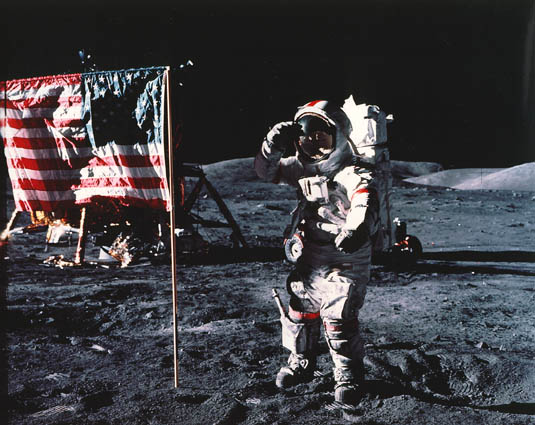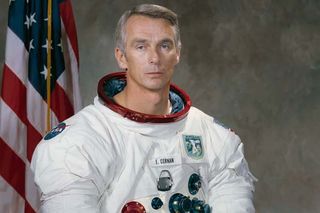'Last Man on the Moon' Documentary Brings Space Exploration Home

On Dec. 14, 1972, Apollo 17 astronaut Gene Cernan became the last person (to date) to set foot on the lunar surface. The story of Cernan's NASA career, and the way it has shaped the rest of his life, is the subject of "Last Man on the Moon," a documentary directed by Mark Craig that opens in select theatres today (Feb. 26).
The story of NASA's Apollo program has been told many, many times in various movies and an almost uncountable number of books. The focus of these narratives tends to fall somewhere between delivering historic information about the program, and attempting to emotionally connect an audience to the people involved.
"Last Man on the Moon" steps away from that typical binary, and instead focuses on bringing the story of the Apollo program into the present day. For many people not old enough to personally remember Apollo and the moon landings, the events that transpired therein, however inspiring, are so distant that they often feel like fiction. It can be difficult to forge an emotional connection to the people who appear in the grainy NASA footage shot in the 1960s and 70s. "Last Man on the Moon" uses Cernan, now in his 80s, as a conduit between then and now. It focuses as much on his late-life reflections as it does on the events themselves. And by digging deep into this man's personal experiences and motivations, it succeeds at telling a very universal — and more importantly, very modern — story.

The opening scenes of "Last Man on the Moon" feature shots of Cernan, in the present day, wandering around a crowded rodeo in Texas, perusing cattle and watching the bull riders hang on for dear life. This is interspersed with historical footage of the Apollo 17 lunar module, in which Cernan was a passenger, touching down on the completely bare lunar surface. Thanks to some cinematic music and suspenseful pacing, the scene is exhilarating. This sequence emphasizes the wonder of the moon landing by reminding the audience that there were real people in that lander — including a man who now walks around on Earth, just like the rest of us.
There are many other sequences in the film that play out in this same fashion. We see Cernan vsit the neighborhood subdivision where he and his wife lived, along with most of the other Apollo astronauts and their families. We see him visit the graves of his friends who died in the Apollo 1 fire (the interview with Martha Horn Chaffee, whose husband Roger died in that fire, is absolutely gut wrenching). Sometimes other people see us better than we see ourselves, and some of the deepest insights in the movie come from Cernan's ex-wife, who at one point says, "If you think it's hard going to the moon, try staying behind." At a Q&A following a screening of the film in New York, Cernan said that until a few years ago, he hadn't comprehended how deeply his spaceflights affected her.
Another example of this type of then-and-now storytelling comes later in the film, following footage of multiple Apollo launches, including scenes from mission control at Johnson Space Center in Houston, and the launch facilities at Cape Canaveral, Florida. The audience once again sees Cernan in the present day, walking around the pad where the Apollo capsules were launched into space aboard Saturn V rockets. The facilities have been unused for years. The equipment is covered with rust, the ground is overrun by weeds, and Cernan's disappointment is deep. He says he wishes he hadn't come, that he doesn't want to remember it like this.
The story of Cernan's astronaut career would provide a perfectly interesting narrative by itself, one full of triumphs and tragedies. But the film doesn't lose its momentum once it passes through that time in Cernan's life (once again making a departure from many documentaries of this kind). The filmmakers place equal emphasis placed on what Cernan chose to do after that spaceflight heyday — how he came back to Earth. He makes late-life reflections about being a poor father and husband during his astronaut career (a sentiment echoed by some of the other former astronauts interviewed for the film). But the viewers also get to see how he tries to atone for those choices and be a better family man, while still leading a life that is intimately tied to his career as an astronaut.
Get the Space.com Newsletter
Breaking space news, the latest updates on rocket launches, skywatching events and more!
The film is based on Cernan's book of the same name, and during the Q&A in New York, Cernan said he initially turned down the filmmakers' request to turn the story into a movie. He was persuaded when it became clear that the film was meant to tell the larger story of the Apollo program, particularly to young people who may not be familiar with it. For decades now, Cernan has worked as a public figure and advocate for space science and human space exploration. The film ends with him delivering an endorsement of NASA's Orion and SLS programs, and the agency's plan for a human mission to Mars.
Even if Cernan didn't want a movie made "about him," he is the reason this particular space documentary works so well. "Last Man on the Moon" works hard to link the young, fearless U.S. Air Force pilot who walked on the moon, to the old man who raises cattle in Texas; in doing so, it links the accomplishments and motivations of the Apollo program with current and future human spaceflight goals. The personal becomes universal, and one man's journey to the moon can be connected to the much larger story of humanity's desire to explore the cosmos.
Follow Calla Cofield @callacofield.Follow us @Spacedotcom, Facebook and Google+. Original article on Space.com.
Join our Space Forums to keep talking space on the latest missions, night sky and more! And if you have a news tip, correction or comment, let us know at: community@space.com.

Calla Cofield joined Space.com's crew in October 2014. She enjoys writing about black holes, exploding stars, ripples in space-time, science in comic books, and all the mysteries of the cosmos. Prior to joining Space.com Calla worked as a freelance writer, with her work appearing in APS News, Symmetry magazine, Scientific American, Nature News, Physics World, and others. From 2010 to 2014 she was a producer for The Physics Central Podcast. Previously, Calla worked at the American Museum of Natural History in New York City (hands down the best office building ever) and SLAC National Accelerator Laboratory in California. Calla studied physics at the University of Massachusetts, Amherst and is originally from Sandy, Utah. In 2018, Calla left Space.com to join NASA's Jet Propulsion Laboratory media team where she oversees astronomy, physics, exoplanets and the Cold Atom Lab mission. She has been underground at three of the largest particle accelerators in the world and would really like to know what the heck dark matter is. Contact Calla via: E-Mail – Twitter